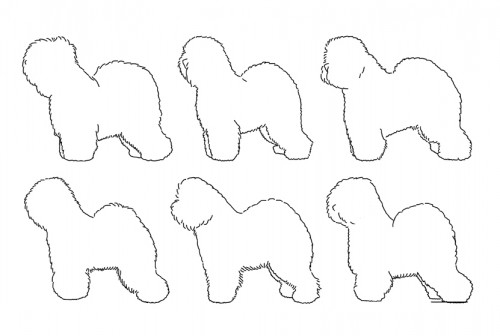Breed Priorities – Old English Sheepdog
Click here to read the complete article
258 – November/December 2019
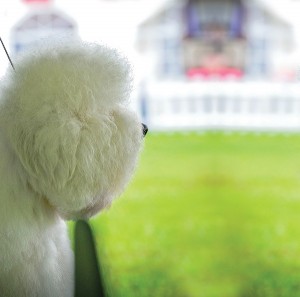 By Nikki Riggsbee
By Nikki Riggsbee
Some breeds are easier to survey to identify their experts’ priorities for evaluating their breeds. Easiest are those breeds with short coats, whose show photos have the dogs in full profile, and those with a great many breeder-judges to invite to participate in the project. The more challenging breeds are missing one to all of those conditions.
The most challenging are breeds with few or no breeder-judges and very few experts in the United States. Then next difficult are those dogs whose show photos are not in profile, are on an angle and facing the camera, and those breeds with heavy coats. It is very hard to find suitable photos to produce outlines for the survey for those breeds that typically face the camera in show photos. Some breeds’ coats conceal their actual outlines in whole or in part, which makes outlines more a reflection of grooming rather than structure.
The Old English Sheepdog is the quintessential breed whose coat disguises its outline and was put off surveying for that alone, yet here we are. In spite of the coat, the experts who contributed to this project could see differences and were reasonably consistent on the outlines that they thought were correct.
I was surprised to find fifty-seven Old English Sheepdog breeder-judges and mentors to invite to take the survey – many more than I expected, although only fifty-one had functioning email addresses. Thirty-four experts agreed to participate. By the deadline, twenty-two completed surveys were received. Those who contributed have been in their breed for nearly forty-four years, and the judges have been approved to judge them for more than twenty-four and a half years. Many of the breeder-judges have judged their national specialty. Many of the non-judges have judged sweepstakes at the national and other specialties.
Old English Sheepdog Virtues
The experts prioritized a list of Old English Sheepdog virtues taken from their breed standard. Below is the list of desired characteristics in sequence by their average ranks, with one being the most important.
1. Compact, square
2. Movement free, powerful, seemingly effortless
3. Stands lower at withers than at loin
4. Skull capacious and rather squarely formed
5 Measurements from withers to elbow and from elbow to ground practically the same
5. Neck fairly long, arched gracefully
7. Even disposition
8. Well muscled with plenty of bone
9. Jaw fairly long, strong, square, truncated
10. Hindquarters round and muscular
11. Ribs well sprung, brisket deep and capacious
12. Well let down hocks
13. Coat profuse, of good hard texture, shaggy
14. Bite level or tight scissors
15. Ears medium-sized, carried flat to side of head
16. A most intelligent expression
Ten of the sixteen virtues garnered majority agreement. Twenty of the group agreed on “Ears medium-sized, carried flat to side of head” (15th) and “A most intelligent expression” (16th). “Ears” was ranked in the last quartile, and “Expression” in the bottom three. Nearly as many put “Compact, square” (1st) in the top quartile.
“Jaw fairly long, strong, square, truncated” (9th) had sixty-eight percent concurring, with the majority mid-point or more important, but five placed it thirteenth or fourteenth, lowering its relative position. Fourteen of the experts agreed on “Movement free, powerful, seemingly effortless” (2nd) and “Bite level or tight scissors” (14th). Two virtues similarly valued on thirteen surveys were “Well let down hocks” (12th) and “Coat profuse, of good hard texture, shaggy” (13th). “Coat” was 10th to 13th for the majority, but seven ranked it in the second quartile.
Twelve put “Stands lower at withers than at loin” (3rd) in the top quartile, while another five had it in the third quartile. Twelve ranked “Neck fairly long, arched gracefully” (tied at 5th) in and around the second quartile.
There was a three-way split on “Skull capacious and rather squarely formed” (4th). Eleven had it 4th through 7th, five had it mid-point or below. and four had it in the top three. Half had “Ribs well sprung, brisket deep and capacious” (11th) 10th to 13th, but six had it 3rd to 5th.
“Measurements from withers to elbow and from elbow to ground practically the same” (tied at 5th) was in the top quartile for ten, but below midpoint for seven. “Hindquarters round and muscular” (10th) had ten in the second quartile and nine in the third quartile
Opinions on “Well muscled with plenty of bone” (8th) split three ways: nine from 10th to 13th, seven from 7th to 9th, and six from 3rd to 5th. “Even disposition” (7th) also had three groupings: seven in the third quartile, six in the top three, and four in the bottom quartile.
“Ears” (15th) and “Expression” (16th) were more than two points on average lower than the adjacent virtue, confirming their place at the bottom.
Some averages were quite close so that additional input could change the relative ranks as well as break the tie at five. “Muscle/bone” and “Jaw strong, square” averaged less than one-tenth of a point apart. We got two more surveys after averaging all the scores. That additional input did indeed cause the placement of some adjacent virtues to swap positions with its neighbor, especially those not at the top or bottom.
Old English Sheepdog Faults
The survey also included a list of faults taken directly from or derived from their standard for the group to prioritize. The faults are listed below in sequence by the average ranks, with one being the most serious.
1. Not square
2. Lacking good reach and drive
3. Shoulders not well laid back
4. Topline not lower at withers than at loin
5. Shy or nervous
6. Long, narrow head or snipy muzzle
7. Slab-sided
8. Not broader at rump than at shoulders
9. Legginess
10. Amber or yellow eye
11. Any shade of brown or fawn
12. Barrel-chested
13. Metatarsus not perpendicular to the ground
14. Softness or flatness of coat
15. Dogs less than 22 inches, bitches less than 21 inches
16. Excessively coated
Ten of the faults–just as ten of the virtues–had majority agreement. Again, twenty of the twenty-two put the last two faults, “Dogs less than 22 inches, bitches less than 21 inches” (15th) in the last quartile, and “Excessively coated” (16th) in the last three positions. “Not square” (1st) was at the top for eighteen, as was the corresponding virtue.
Three faults were similarly valued on fourteen surveys: “Lacking good reach and drive” (2nd), “Shoulders not well laid back” (3rd), and “Slab-sided” (7th). “Lacking reach/drive” (2nd) was in the top quartile for the majority, but five put it around the middle. “Straight shoulders” (3rd) was 4th through 7th for nearly two-thirds, but five ranked it in the top three. “Slab-sided” (7th) was in the second quartile for fourteen and in the third quartile for six.
“Softness or flatness of coat” (14th) ranked in the third quartile on thirteen surveys and the last quartile on six. Three faults garnered the smallest majorities: “Topline not lower at withers than at loin” (4th), “Long, narrow head or snipy muzzle” (6th), and “Barrel-chested” (12th). “Topline not rising” (4th) was in the top quartile for twelve, as was the corresponding virtue, but around the middle for five. “Long, narrow head” (6th) had a similar split a few positions lower. “Barrel-chested” (12th) was 11th to 14th for most, but eight ranked it around the middle.
Half the group concurred on “Any shade of brown or fawn” (11th) and “Metatarsus not perpendicular to the ground” (13th). “Brown/fawn” was at or near the last quartile for half, but five thought it quite important. Eleven ranked “Hocks not perpendicular” (13th) in the last quartile, but seven had it middling or above.
Ten had “Not broader at rump than at shoulders” (8th) around the middle, although eight thought it somewhat more important. Ten had “Legginess” (9th) above average as a problem, but another ten placed it in the third quartile. “Amber or yellow eye” (10th) was at or near the last quartile for ten, but nine had it closer to the middle. “Shy or nervous” (5th) was in the top quartile for nine, the third quartile for seven, and 5th or 6th for five, split as temperament was as a virtue.
Over two points separated the averages of the ninth and tenth faults, confirming the greater seriousness of the top nine faults. The average of the fifteenth fault was three-and-one-half points lower than the fourteenth-placed fault, emphasizing that the bottom two faults were much less of a problem than the others.
The group was quite consistent between the two lists. Square/not square was first on both lists and movement second. Rising topline third as a virtue, lacking it was fourth as a fault. Temperament above average on both. Ribs/chest below average on both, and coat fairly low.
Outlines
The survey included two sets of outlines, one of dogs and one of bitches, for the experts to place as they would a class of dogs at a show. The outlines were made from photos of good to excellent dogs, but they were real dogs, so none is perfect. The coat obscures the actual dog, but those in the breed were able to see through the coat. Still, a thorough hands-on exam is required with this breed. That, movement and more could change these placements.
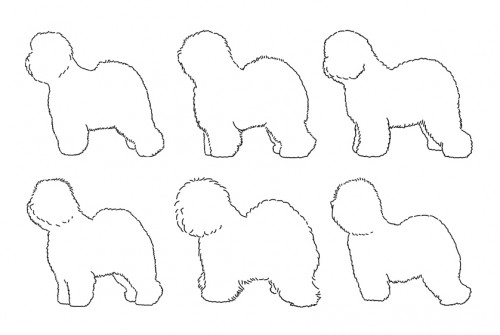
The dog with the best average placement was OES “B.” Those who placed him first said “square, leg length to height, length of neck,” “best shoulders, balance,” “good proportions,” “complementary angles,” “rise over loin, long neck,” and “upper arm steep, front legs too far forward.”
There was a tie for second place on placement average, but “D” had one more first placement than “F,” so “D” will be runner-up. Those who liked him said “square outline, arched neck, enough leg, correct angulation, good proportion,” “neck,” “breed type, attractive outline, well covered with hair,” and “square.”
OES “X” was the bitch with the best average placement. Comments on her included “best balance, up on leg, square, arched neck, balanced angulation,” “most balanced,” “adequate front,” “adequate layback and length of neck, nice bend of stifle, upper arm steep,” and “correct proportions, could have a bit more neck.”
The bitch with the next best average placement was OES “U.” Notes from those who chose her said “breed type, square, head, topline,” “balanced, compact,” and “shorter back, lacks neck.”
Best of Breed didn’t have overwhelming agreement. Bitch “X” had the best average placement, but dog “B” had two more first placements than “X.” Dog “B” was named BOB seven times, more than any other. Only three bitches were BOB – “U,” “V,” and “W”– one time each. All other nineteen Bests of Breed were dogs. Some suggested that the dog outlines were better than the bitches, so it may well have not been a gender preference.
Every outline was placed first at least once except for “C” and “Y.” Dog “C” and bitches “Y” and “Z” were unplaced on fifteen surveys.
Essential Characteristics
The experts were asked to list four to six characteristics that a good Old English Sheepdog must have. Square and head (strong, square, truncated muzzle) were listed most often followed by topline (rise to a higher loin), coat (texture, harsh guard hairs,) and movement (easy reach and drive.) All but coat were consistent with the lists and the reasons given for selecting outlines.
Additional Notes
The Old English Sheepdog experts offered these suggestions for students of their breed.
• “Soundness is of the greatest importance” – from the standard.
• Topline is the hallmark of the breed.
• Coat texture should feel crisp.
• The OES is a working dog, movement is essential.
• Make sure you properly feel the topline; with your hand, slide from the withers back to feel the rise over the short loin.
• The head is two bricks with a square, full muzzle.
• Try to see some shaved dogs to understand what you must feel.
• Pear-shaped body and square head.
• It’s a hands-on breed. Skillful grooming can hide faults. Don’t be afraid to mess up the coat.
• Do not award wins to hair-sprayed and back-combed dogs.
Much appreciation to the Old English Sheepdog experts who contributed their expertise to this project.
Official Standard of the Old English Sheepdog
General Appearance: A strong, compact, square, balanc-ed dog. Taking him all around, he is profusely, but not exces-sively coated, thickset, muscular and able-bodied. These qualities, combined with his agility, fit him for the demanding tasks required of a shepherd’s or drover’s dog. Therefore, soundness is of the greatest importance. His bark is loud with a distinctive “pot- casse” ring in it.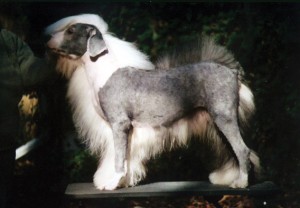
Size, Proportion, Substance: Type, character and balance are of greater importance and are on no account to be sacrificed to size alone. Size - Height (measured from top of withers to the ground), Dogs: 22 inches (55.8 centimeters) and upward. Bitches: 21 inches (53.3 centimeters) and upward. Proportion - Length (measured from point of shoulder to point of ischium (tuberosity) practically the same as the height. Absolutely free from legginess or weaselness. Substance – Well muscled with plenty of bone.
Head - A most intelligent expression. Eyes - Brown, blue or one of each. If brown, very dark is preferred. If blue, a pearl, china or wall-eye is considered typical. An amber or yellow eye is most objectionable. Ears - Medium sized and carried flat to the side of the head. Skull - Capacious and rather squarely formed giving plenty of room for brain power. The parts over the eyes (supra-orbital ridges) are well arched. The whole well covered with hair. Stop - Well defined. Jaw - Fairly long, strong, square and truncated. Attention is particularly called to the above properties as a long, narrow head or snipy muzzle is a deformity. Nose - Always black, large and capacious. Teeth - Strong, large and evenly placed. The bite is level or tight scissors.
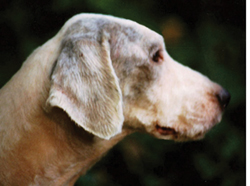 Neck, Topline, Body: Neck - Fairly long and arched gracefully. Topline - Stands lower at the withers than at the loin with no indication of softness or weakness. Attention is particularly called to this topline as it is a distinguishing characteristic of the breed. Body - Rather short and very compact, broader at the rump than at the shoulders, ribs well sprung and brisket deep and capacious. Neither slab-sided nor barrel-chested. The loin is very stout and gently arched. Tail - Docked close to the body, when not naturally bob tailed.
Neck, Topline, Body: Neck - Fairly long and arched gracefully. Topline - Stands lower at the withers than at the loin with no indication of softness or weakness. Attention is particularly called to this topline as it is a distinguishing characteristic of the breed. Body - Rather short and very compact, broader at the rump than at the shoulders, ribs well sprung and brisket deep and capacious. Neither slab-sided nor barrel-chested. The loin is very stout and gently arched. Tail - Docked close to the body, when not naturally bob tailed.
Forequarters: Shoulders well laid back and narrow at the points. The forelegs dead straight with plenty of bone. The measurements from the withers to the elbow and from the elbow to the ground are practically the same.
Hindquarters: Round and muscular with well let down hocks. When standing, the metatarsus are perpendicular to the ground when viewed from any angle.
Feet: Small and round, toes well arched, pads thick and hard, feet pointing straight ahead.
Coat: Profuse, but not so excessive as to give the impression of the dog being overly fat, and of a good hard texture; not straight, but shaggy and free from curl. Quality and texture of coat to be considered above mere profuseness. Softness or flatness of coat to be considered a fault. The undercoat is a waterproof pile when not removed by grooming or season. Ears coated moderately. The whole skull well covered with hair. The neck well coated with hair. The forelegs well coated all around. The hams densely coated with a thick, long jacket in excess of any other part. Neither the natural outline nor the natural texture of the coat may be changed by any artificial means except that the feet and rear may be trimmed for cleanliness.
Color: Any shade of gray, grizzle, blue or blue merle with or without white markings or in reverse. Any shade of brown or fawn to be considered distinctly objectionable and not to be encouraged.
Gait: When trotting, movement is free and powerful, seemingly effortless, with good reach and drive, and covering maximum ground with minimum steps. Very elastic at a gallop. May amble or pace at slower speeds.
Temperament: An adaptable, intelligent dog of even disposition, with no sign of aggression, shyness or nervousness.
Approved February 10, 1990 – Effective March 28, 1990
photos above courtesy of the Old English Sheepdog Club of America
Click here to read the complete article
258 – November/December 2019
Short URL: https://caninechronicle.com/?p=174408
Comments are closed











